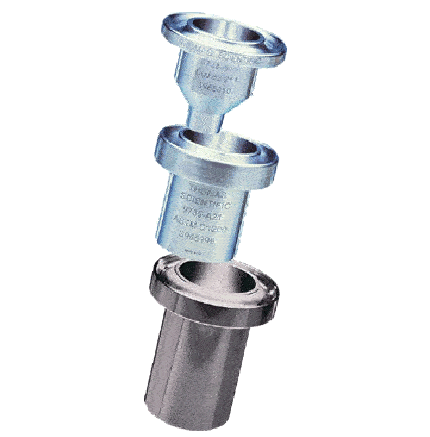
Equations for conversion of kinematic viscosity or viscosity into other viscometric units are given here. All data must be at 25°C. Note that the equations apply only between the minimum and maximum drain times shown. While the equations in the table below are widely used, the equation v = at – b/t is often more […]
Equations for conversion of kinematic viscosity or viscosity into
other viscometric units are given here. All data must be at 25°C. Note
that the equations apply only between the minimum and maximum drain
times shown.
While the equations in the table below are widely used, the
equation v = at – b/t is often more applicable, especially at low flow
times and low kinematic viscosity.
Viscosity Standards for Zahn, Shell, and Ford Cups
| Viscosity Standard |
Kin Vis mm2/s (cSt/s)
|
Zahn Cup
|
Shell Cup
|
Ford Cup
|
|||
|
Size
|
Drain time, sec
|
Size
|
Drain time, sec
|
Size
|
Drain time, sec
|
||
|
C6 |
8.9
|
–
|
–
|
1
|
52
|
–
|
–
|
|
C10 |
17
|
1
|
45
|
2
|
35
|
1
|
70
|
|
C20 |
34
|
1
|
60
|
2
|
64
|
2
|
42
|
|
2½
|
40
|
–
|
–
|
||||
|
C35 |
66
|
2
|
33
|
2½
|
74
|
2
|
64
|
|
3
|
46
|
3
|
35
|
||||
|
3½
|
32
|
–
|
–
|
||||
|
C60 |
120
|
2
|
48
|
3½
|
57
|
3
|
58
|
|
4
|
36
|
4
|
36
|
||||
|
C100 |
230
|
3
|
27
|
4
|
68
|
4
|
64
|
|
4
|
21
|
5
|
36
|
–
|
–
|
||
|
C200 |
460
|
3
|
47
|
5
|
72
|
5
|
40
|
|
4
|
36
|
6
|
29
|
–
|
–
|
||
|
C350 |
850
|
4
|
62
|
6
|
53
|
5
|
70
|
|
5
|
37
|
–
|
–
|
–
|
–
|
||
|
C600 |
1600
|
5
|
70
|
–
|
–
|
–
|
–
|
|
Cup Number
|
Equations* where
t = Time of flow, seconds v = kinematic viscosity, mm2/s |
Drain time seconds
|
Kinematic viscosity centistokes
|
||
|
min
|
max
|
min
|
max
|
||
|
Zahn Cups (See ASTM D 4212)
|
|||||
|
1
|
v = 1.1 (t – 29)
|
35
|
80
|
5
|
60
|
|
2
|
v = 3.5 (t – 14)
|
20
|
80
|
20
|
250
|
|
3
|
v = 11.7 (t – 7.5)
|
20
|
80
|
100
|
800
|
|
4
|
v = 14.8 (t – 5)
|
20
|
80
|
200
|
1200
|
|
5
|
v = 23t
|
20
|
80
|
400
|
1800
|
|
Shell Cups (See ASTM D 4212)
|
|||||
|
1
|
v = 0.226 (t – 13)
|
20
|
80
|
2
|
20
|
|
2
|
v = 0.576 (t – 5)
|
20
|
80
|
10
|
50
|
|
2½
|
v = 0.925 (t – 3)
|
20
|
80
|
20
|
80
|
|
3
|
v = 1.51 (t – 2)
|
20
|
80
|
30
|
120
|
|
3½
|
v = 2.17 (t – 1.5)
|
20
|
80
|
40
|
170
|
|
4
|
v = 3.45 (t – 1)
|
20
|
80
|
70
|
270
|
|
5
|
v = 6.5 (t – 1)
|
20
|
80
|
125
|
520
|
|
6
|
v= 16.2 (t – 0.5)
|
20
|
80
|
320
|
1300
|
|
Ford Cups (See ASTM D 1200)
|
|||||
|
1
|
v = 0.49 (t – 35.0)
|
55
|
100
|
10
|
35
|
|
2
|
v = 1.44 (t – 18.0)
|
40
|
100
|
25
|
120
|
|
3
|
v = 2.31 (t – 6.58)
|
20
|
100
|
49
|
220
|
|
4
|
v = 3.85 (t – 4.49)
|
20
|
100
|
70
|
370
|
|
5
|
v = 12.1 (t – 2.00)
|
20
|
100
|
200
|
1200
|
* While the equations in this table are widely used, the equation v = at – b/t is often more applicable, especially at low flow times and low kinematic viscosity.